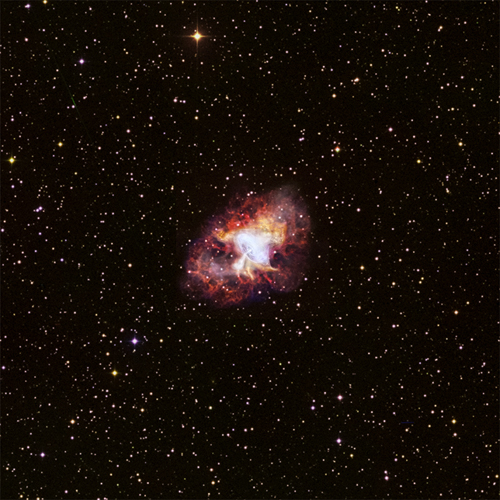This page, updated monthly, will let you know some of the things that you can look out for in the night sky. It lists the phases of the Moon, where you will see the naked-eye planets and describes some of the prominent constellations in the night sky during the month.
Highlights of the Month
September - A good month to observe Neptune with a small telescope.
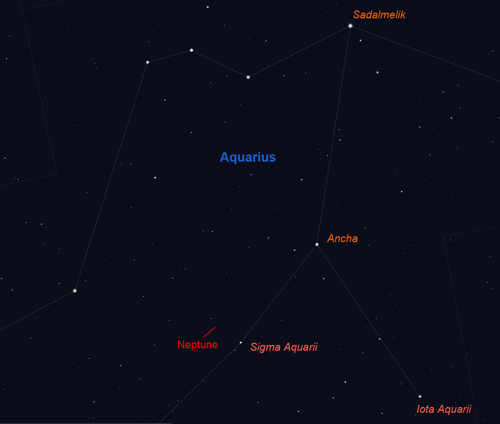
Neptune in Aquarius
Image: Stellarium/IM
Neptune comes into opposition - when it is nearest the Earth - on the 29th of August, so will be seen well both this month. Its magnitude is +7.9 so Neptune is easily spotted in binoculars lying in the constellation Aquarius as shown on the chart. It rises to an elevation of ~27 degrees when due south. Given a telescope of 8 inches or greater aperture and a dark tranparent night it should even be possible to spot its moon Triton.
September 5th - half an hour before sunrise: Venus close to Regulus in Leo
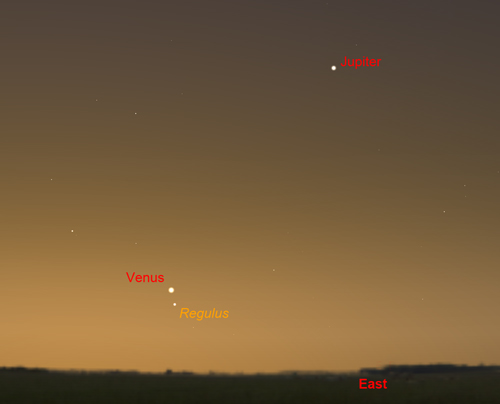
Venus close to Regulus in Leo
Image: Stellarium/IM
Looking East before sunrise you should, if clear, be able to spot Venus one degree (59 minutes, 46 arc seconds to be precise)to the upper left of Regulus, Alpha Leonis.
August 5th - one hour after sunset: Antares, Mars and Saturn lying in the Southwest

Antares, Mars and Saturn
Image: Stellarium/IM
Given a good low unobstructed horizon and looking Southwest after sunset you should be able to spot Mars, magnitude 0.6, lying between Antares, magnitude 0.9 , to its left and Saturn, magnitude +0.6, lying to its right. to/p>
August 20th - before dawn: Jupiter and a thin crescent Moon
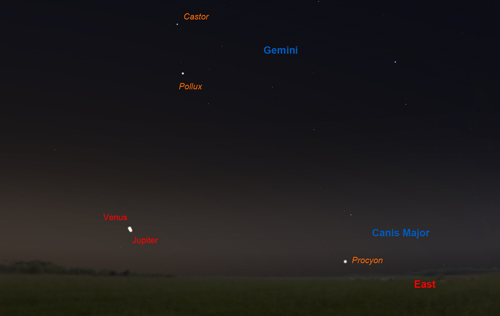
Venus and Jupiter
Image: Stellarium/IM
Looking East before dawn, Jupiter, at magnitude -1.9, will be seen just under 6 degrees up and to the left of a thin crescent Moon.
August 27th and 28th - after sunset: Saturn, Mars and a thin crescent Moon
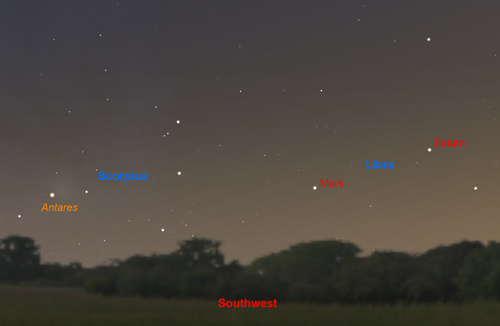
Mars, Saturn and a thin crescent Moon.
Image: Stellarium/IM
After sunset on the 27th and given a low western horizon you may be able to spot a very thin crescent Moon lying down to the right of Saturn in Libra. On the next night a fuller crescent Moon will lie halfway betwen Mars and Saturn. On both nights, Mars will be lying just over 3 degree above Antares in Scorpius.
September: 14th and 26/27th: The Alpine Valley
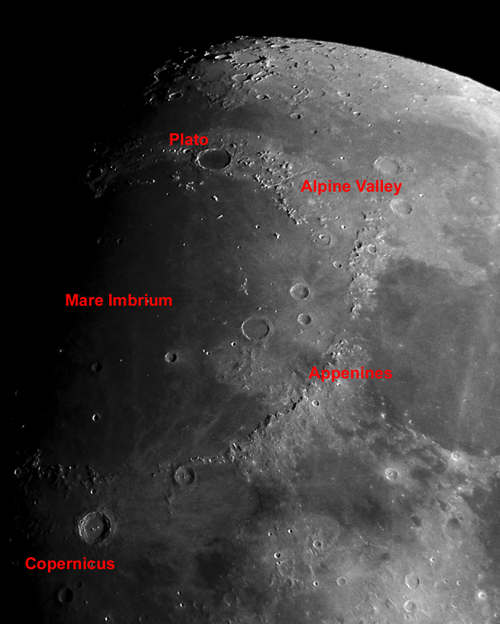
Alpine Valley region
An interesting valley on the Moon: The Alpine Valley
These are good nights to observe an interesting feature on the Moon if you have a small telescope. Close to the limb is the Appenine mountain chain that marks the edge of Mare Imbrium. Towards the upper end you should see the cleft across them called the Alpine valley. It is about 7 miles wide and 79 miles long. As shown in the image a thin rill runs along its length which is quite a challenge to observe. Over the next two nights following the 3rd/4th the dark crater Plato and the young crater Copernicus will come into view. This is a very interesting region of the Moon!
[Note: you might wonder how the above dates were found. There is a excellent free program called "Virtual Moon Atlas" which allows one to see what will be visible on any night - one then simply finds when the terminator will be close to the object of interest.]

The Alpine valley and the crater Plato
A Messier Object imaged with the Faulkes Telescope: M82 in Ursar Major
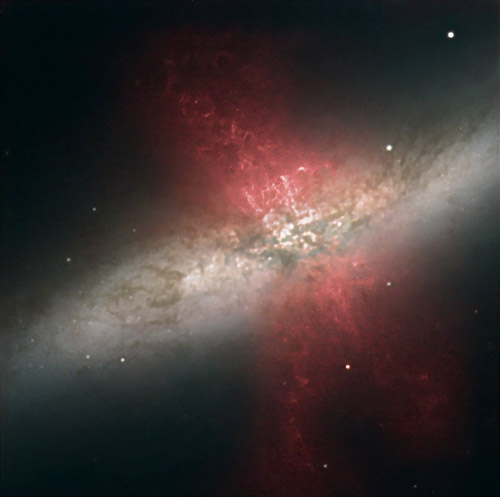
NGC1365
Image:Danial Duggan
Faulkes Telescope North.
Galaxy M82, imaged by Daniel Duggan.
This image was taken using the Faulkes Telescope North by Danial Duggan - for some time a member of the Faulkes telescope team. Lying at at distance of 12 million light years in the constellation Ursa Major, it makes a pair with M81. Tidal interactions between them have initiated a "burst" of star formation hence it is called a "starburst" galaxy. At its heart, one star becomes a supernova every 30 years or so and their evolution is being studied by radio telescopes such as the Jodrell Bank MERLIN array and the European VLBI network that can image the expanding shell of gas resulting from the stellar explosions.
Learn more about the Faulkes Telescopes and how schools can use them: Faulkes Telescope"
Use the link below to find when the space station will be visible in the next few days. In general, the space station can be seen either in the hour or so before dawn or the hour or so after sunset - this is because it is dark and yet the Sun is not too far below the horizon so that it can light up the space station. As the orbit only just gets up the the latitude of the UK it will usually be seen to the south, and is only visible for a minute or so at each sighting. Note that as it is in low-earth orbit the sighting details vary quite considerably across the UK. The NASA website linked to below gives details for several cities in the UK. (Across the world too for foreign visitors to this web page.)
Note: I observed the ISS three times recently and was amazed as to how bright it has become.
The Planets

A montage of the Solar System. JPL / Nasa
Jupiter

A Cassini image of Jupiter . Nasa
Jupiter shining at magnitude -1.8 begins the month just 2.5 degrees to the lower left of M44, the Beehive Cluster, in Cancer. It is moving down towards Leo which it will reach in the middle of October. At the start of September it rises two and a half hours before the Sun and this increases to four and a half hours by months end. As the Earth moves towards Jupiter, the size of Jupiter's disk increases slightly from 32.1 to 13.6 arc seconds so early risers should be able to see the equatorial bands in the atmosphere and the four Gallilean moons as they weave their way around it.
See highlight above.
Saturn

The planet Saturn. Cassini - Nasa
Saturn can be seen after sunset low in the southwest. It lies in Libra, moving slowly away from the wide double star Alpha Librae as it shines with a magnitude of +0.6. One hour after sunset at the start of the month it will lie ~20 degrees above the horizon so the atmosphere will limit the view of its 16.2 (falling to 15.6) arc second disk. By month's end it will only be at 10 degrees elevation at this time so this is our last chance to observe it for a month or so as it passes behind the Sun. The ring system, which has now opened out to 23 degrees to the line of sight, should still show nicely along with Titan, its largest satellite.
See highlights above.
Mercury

Messenger image of Mercury Nasa
Mercury has a very poor evening apparition this month as, though it is at greatest elongation 26 degrees east of the Sun on September 21st it will be at a very low elevation as at this time of the year the ecliptic makes a very shallow angle to the horizon. To find it on the evening of the 20th given a clear low western horizon, note where the Sun sets and (ONLY!) then use binoculars to sweep to 25 degrees to to the left of that point and between 5 and 10 degrees above the horizon. Mercury,in Virgo at magnitude zero, will be seen just half a degree below first magnitude Spica.
Mars

A Hubble Space Telescope image of Mars.
Jim Bell et al. AURA / STScI / Nasa
Mars is moving eastwards relative to thr stars form Libra into Scorpius ending the month close to Antares. It dims from +0.6 to +0.8 during the month and its disk falls from an angular size of 6.8 down to 6.1 arc seconds. It is best observed as darkness falls but, given its low elevation, it is unlikely that any details will be seen on its salmon-pink suface. Due to its movement eastwards it sets about three hours after the Sun all month, On the 12th it will lie halfway between Saturn and Antares and on the 17th will lie just half a degree above the second magnitude star Delta Scorpii.
See highlight above.
Venus

Venus showing some cloud structure
Venus, rises in the east-northeast in the pre dawn sky an hour before the Sun at the start of September but this reduces to half an hour by month's end. Shining at magnitude -3.9 it can be spotted in Leo well down to the lower left of Jupiter as the month begins. On the 5th and 6th it will lie just half a degree above (the 5th) and then to the left (the 6th) of first magnitude Regulus.
See highlight above.

Radar image showing surface features
Find more planetary images and details about the Solar System: The Solar System
The Stars
The Evening September Sky
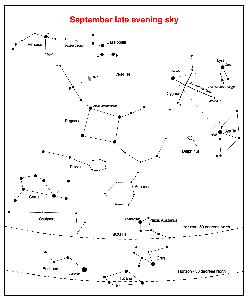 The September Sky in the south - early Sept:~11pm, late Sept:~10pm
The September Sky in the south - early Sept:~11pm, late Sept:~10pm
This map shows the constellations seen towards the south in late evening. To the south in early evening moving over to the west as the night progresses is the beautiful region of the Milky Way containing both Cygnus and Lyra. Below is Aquilla. The three bright stars Deneb (in Cygnus), Vega (in Lyra) and Altair (in Aquila) make up the "Summer Triangle". East of Cygnus is the great square of Pegasus - adjacent to Andromeda in which lies M31, the Andromeda Nebula. To the north lies "w" shaped Cassiopeia and Perseus.
The constellations Lyra and Cygnus

Lyra and Cygnus
This month the constellations Lyra and Cygnus are seen almost overhead as darkness falls with their bright stars Vega, in Lyra, and Deneb, in Cygnus, making up the "summer triangle" of bright stars with Altair in the constellation Aquila below. (see sky chart above)
Lyra
Lyra is dominated by its brightest star Vega, the fifth brightest star in the sky. It is a blue-white star having a magnitude of 0.03, and lies 26 light years away. It weighs three times more than the Sun and is about 50 times brighter. It is thus burning up its nuclear fuel at a greater rate than the Sun and so will shine for a correspondingly shorter time. Vega is much younger than the Sun, perhaps only a few hundred million years old, and is surrounded by a cold,dark disc of dust in which an embryonic solar system is being formed!
There is a lovely double star called Epsilon Lyrae up and to the left of Vega. A pair of binoculars will show them up easily - you might even see them both with your unaided eye. In fact a telescope, provided the atmosphere is calm, shows that each of the two stars that you can see is a double star as well so it is called the double double!

Epsilon Lyra - The Double Double
Between Beta and Gamma Lyra lies a beautiful object called the Ring Nebula. It is the 57th object in the Messier Catalogue and so is also called M57. Such objects are called planetary nebulae as in a telescope they show a disc, rather like a planet. But in fact they are the remnants of stars, similar to our Sun, that have come to the end of their life and have blown off a shell of dust and gas around them. The Ring Nebula looks like a greenish smoke ring in a small telescope, but is not as impressive as it is shown in photographs in which you can also see the faint central "white dwarf" star which is the core of the original star which has collapsed down to about the size of the Earth. Still very hot this shines with a blue-white colour, but is cooling down and will eventually become dark and invisible - a "black dwarf"! Do click on the image below to see the large version - its wonderful!

M57 - the Ring Nebula
Image: Hubble Space telescope
M56 is an 8th magnitude Globular Cluster visible in binoculars roughly half way between Alberio (the head of the Swan) and Gamma Lyrae. It is 33,000 light years away and has a diameter of about 60 light years. It was first seen by Charles Messier in 1779 and became the 56th entry into his catalogue.

M56 - Globular Cluster
Cygnus
Cygnus, the Swan, is sometimes called the "Northern Cross" as it has a distinctive cross shape, but we normally think of it as a flying Swan. Deneb,the arabic word for "tail", is a 1.3 magnitude star which marks the tail of the swan. It is nearly 2000 light years away and appears so bright only because it gives out around 80,000 times as much light as our Sun. In fact if Deneb where as close as the brightest star in the northern sky, Sirius, it would appear as brilliant as the half moon and the sky would never be really dark when it was above the horizon!
The star, Albireo, which marks the head of the Swan is much fainter, but a beautiful sight in a small telescope. This shows that Albireo is made of two stars, amber and blue-green, which provide a wonderful colour contrast. With magnitudes 3.1 and 5.1 they are regarded as the most beautiful double star that can be seen in the sky.

Alberio: Diagram showing the colours and relative brightnesses
Cygnus lies along the line of the Milky Way, the disk of our own Galaxy, and provides a wealth of stars and clusters to observe. Just to the left of the line joining Deneb and Sadr, the star at the centre of the outstretched wings, you may, under very clear dark skys, see a region which is darker than the surroundings. This is called the Cygnus Rift and is caused by the obscuration of light from distant stars by a lane of dust in our local spiral arm. the dust comes from elements such as carbon which have been built up in stars and ejected into space in explosions that give rise to objects such as the planetary nebula M57 described above.
There is a beautiful region of nebulosity up and to the left of Deneb which is visible with binoculars in a very dark and clear sky. Photographs show an outline that looks like North America - hence its name the North America Nebula. Just to its right is a less bright region that looks like a Pelican, with a long beak and dark eye, so not surprisingly this is called the Pelican Nebula. The photograph below shows them well.

The North American Nebula
Brocchi's Cluster An easy object to spot with binoculars in Gygnus is "Brocchi's Cluster", often called "The Coathanger",although it appears upside down in the sky! Follow down the neck of the swan to the star Alberio, then sweep down and to its lower left. You should easily spot it against the dark dust lane behind.

Brocchi's Cluster - The Coathanger
The constellations Pegasus and Andromeda
 Pegasus and Andromeda
Pegasus and Andromeda
Pegasus
The Square of Pegasus is in the south during the evening and forms the body of the winged horse. The square is marked by 4 stars of 2nd and 3rd magnitude, with the top left hand one actually forming part of the constellation Andromeda. The sides of the square are almost 15 degrees across, about the width of a clentched fist, but it contains few stars visibe to the naked eye. If you can see 5 then you know that the sky is both dark and transparent! Three stars drop down to the right of the bottom right hand corner of the square marked by Alpha Pegasi, Markab. A brighter star Epsilon Pegasi is then a little up to the right, at 2nd magnitude the brightest star in this part of the sky. A little further up and to the right is the Globular Cluster M15. It is just too faint to be seen with the naked eye, but binoculars show it clearly as a fuzzy patch of light just to the right of a 6th magnitude star.
Andromeda
The stars of Andromeda arc up and to the left of the top left star of the square, Sirra or Alpha Andromedae. The most dramatic object in this constellation is M31, the Andromeda Nebula. It is a great spiral galaxy, similar to, but somewhat larger than, our galaxy and lies about 2.5 million light years from us. It can be seen with the naked eye as a faint elliptical glow as long as the sky is reasonably clear and dark. Move up and to the left two stars from Sirra, these are Pi amd Mu Andromedae. Then move your view through a rightangle to the right of Mu by about one field of view of a pair of binoculars and you should be able to see it easily. M31 contains about twice as many stars as our own galaxy, the Milky Way, and together they are the two largest members of our own Local Group of about 3 dozen galaxies.
 M31 - The Andromeda Nebula
M31 - The Andromeda Nebula
M33 in Triangulum
If, using something like 8 by 40 binoculars, you have seen M31 as described above, it might well be worth searching for M33 in Triangulum. Triangulum is
the small faint constellation just below Andromeda. Start on M31, drop down to Mu Andromedae and keep on going in the same direction by the same distance as you have moved from M31 to Mu Andromedae. Under excellent seeing conditions (ie., very dark and clear skies) you should be able to see what looks like a little piece of tissue paper stuck on the sky or a faint cloud. It appears to have uniform brightness and shows no structure. The shape is irregular in outline - by no means oval in shape and covers an area about twice the size of the Moon. It is said that it is just visible to the unaided eye, so it the most distant object in the Universe that the eye can see. The distance is now thought to be 3.0 Million light years - just greater than that of M31.
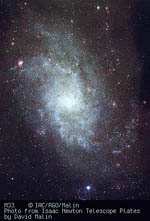 M33 in triangulum - David Malin
M33 in triangulum - David Malin
The Evening September Sky
 The September Sky in the south - early Sept:~11pm, late Sept:~10pm
The September Sky in the south - early Sept:~11pm, late Sept:~10pm
This map shows the constellations seen towards the south in late evening. To the south in early evening moving over to the west as the night progresses is the beautiful region of the Milky Way containing both Cygnus and Lyra. Below is Aquilla. The three bright stars Deneb (in Cygnus), Vega (in Lyra) and Altair (in Aquila) make up the "Summer Triangle". East of Cygnus is the great square of Pegasus - adjacent to Andromeda in which lies M31, the Andromeda Nebula. To the north lies "w" shaped Cassiopeia and Perseus.
The constellations Lyra and Cygnus

Lyra and Cygnus
This month the constellations Lyra and Cygnus are seen almost overhead as darkness falls with their bright stars Vega, in Lyra, and Deneb, in Cygnus, making up the "summer triangle" of bright stars with Altair in the constellation Aquila below. (see sky chart above)
Lyra
Lyra is dominated by its brightest star Vega, the fifth brightest star in the sky. It is a blue-white star having a magnitude of 0.03, and lies 26 light years away. It weighs three times more than the Sun and is about 50 times brighter. It is thus burning up its nuclear fuel at a greater rate than the Sun and so will shine for a correspondingly shorter time. Vega is much younger than the Sun, perhaps only a few hundred million years old, and is surrounded by a cold,dark disc of dust in which an embryonic solar system is being formed!
There is a lovely double star called Epsilon Lyrae up and to the left of Vega. A pair of binoculars will show them up easily - you might even see them both with your unaided eye. In fact a telescope, provided the atmosphere is calm, shows that each of the two stars that you can see is a double star as well so it is called the double double!

Epsilon Lyra - The Double Double
Between Beta and Gamma Lyra lies a beautiful object called the Ring Nebula. It is the 57th object in the Messier Catalogue and so is also called M57. Such objects are called planetary nebulae as in a telescope they show a disc, rather like a planet. But in fact they are the remnants of stars, similar to our Sun, that have come to the end of their life and have blown off a shell of dust and gas around them. The Ring Nebula looks like a greenish smoke ring in a small telescope, but is not as impressive as it is shown in photographs in which you can also see the faint central "white dwarf" star which is the core of the original star which has collapsed down to about the size of the Earth. Still very hot this shines with a blue-white colour, but is cooling down and will eventually become dark and invisible - a "black dwarf"! Do click on the image below to see the large version - its wonderful!

M57 - the Ring Nebula
Image: Hubble Space telescope
M56 is an 8th magnitude Globular Cluster visible in binoculars roughly half way between Alberio (the head of the Swan) and Gamma Lyrae. It is 33,000 light years away and has a diameter of about 60 light years. It was first seen by Charles Messier in 1779 and became the 56th entry into his catalogue.

M56 - Globular Cluster
Cygnus
Cygnus, the Swan, is sometimes called the "Northern Cross" as it has a distinctive cross shape, but we normally think of it as a flying Swan. Deneb,the arabic word for "tail", is a 1.3 magnitude star which marks the tail of the swan. It is nearly 2000 light years away and appears so bright only because it gives out around 80,000 times as much light as our Sun. In fact if Deneb where as close as the brightest star in the northern sky, Sirius, it would appear as brilliant as the half moon and the sky would never be really dark when it was above the horizon!
The star, Albireo, which marks the head of the Swan is much fainter, but a beautiful sight in a small telescope. This shows that Albireo is made of two stars, amber and blue-green, which provide a wonderful colour contrast. With magnitudes 3.1 and 5.1 they are regarded as the most beautiful double star that can be seen in the sky.

Alberio: Diagram showing the colours and relative brightnesses
Cygnus lies along the line of the Milky Way, the disk of our own Galaxy, and provides a wealth of stars and clusters to observe. Just to the left of the line joining Deneb and Sadr, the star at the centre of the outstretched wings, you may, under very clear dark skys, see a region which is darker than the surroundings. This is called the Cygnus Rift and is caused by the obscuration of light from distant stars by a lane of dust in our local spiral arm. the dust comes from elements such as carbon which have been built up in stars and ejected into space in explosions that give rise to objects such as the planetary nebula M57 described above.
There is a beautiful region of nebulosity up and to the left of Deneb which is visible with binoculars in a very dark and clear sky. Photographs show an outline that looks like North America - hence its name the North America Nebula. Just to its right is a less bright region that looks like a Pelican, with a long beak and dark eye, so not surprisingly this is called the Pelican Nebula. The photograph below shows them well.

The North American Nebula
Brocchi's Cluster An easy object to spot with binoculars in Gygnus is "Brocchi's Cluster", often called "The Coathanger",although it appears upside down in the sky! Follow down the neck of the swan to the star Alberio, then sweep down and to its lower left. You should easily spot it against the dark dust lane behind.

Brocchi's Cluster - The Coathanger
The constellations Pegasus and Andromeda
 Pegasus and Andromeda
Pegasus and Andromeda
Pegasus
The Square of Pegasus is in the south during the evening and forms the body of the winged horse. The square is marked by 4 stars of 2nd and 3rd magnitude, with the top left hand one actually forming part of the constellation Andromeda. The sides of the square are almost 15 degrees across, about the width of a clentched fist, but it contains few stars visibe to the naked eye. If you can see 5 then you know that the sky is both dark and transparent! Three stars drop down to the right of the bottom right hand corner of the square marked by Alpha Pegasi, Markab. A brighter star Epsilon Pegasi is then a little up to the right, at 2nd magnitude the brightest star in this part of the sky. A little further up and to the right is the Globular Cluster M15. It is just too faint to be seen with the naked eye, but binoculars show it clearly as a fuzzy patch of light just to the right of a 6th magnitude star.
Andromeda
The stars of Andromeda arc up and to the left of the top left star of the square, Sirra or Alpha Andromedae. The most dramatic object in this constellation is M31, the Andromeda Nebula. It is a great spiral galaxy, similar to, but somewhat larger than, our galaxy and lies about 2.5 million light years from us. It can be seen with the naked eye as a faint elliptical glow as long as the sky is reasonably clear and dark. Move up and to the left two stars from Sirra, these are Pi amd Mu Andromedae. Then move your view through a rightangle to the right of Mu by about one field of view of a pair of binoculars and you should be able to see it easily. M31 contains about twice as many stars as our own galaxy, the Milky Way, and together they are the two largest members of our own Local Group of about 3 dozen galaxies.
 M31 - The Andromeda Nebula
M31 - The Andromeda Nebula
M33 in Triangulum
If, using something like 8 by 40 binoculars, you have seen M31 as described above, it might well be worth searching for M33 in Triangulum. Triangulum is
the small faint constellation just below Andromeda. Start on M31, drop down to Mu Andromedae and keep on going in the same direction by the same distance as you have moved from M31 to Mu Andromedae. Under excellent seeing conditions (ie., very dark and clear skies) you should be able to see what looks like a little piece of tissue paper stuck on the sky or a faint cloud. It appears to have uniform brightness and shows no structure. The shape is irregular in outline - by no means oval in shape and covers an area about twice the size of the Moon. It is said that it is just visible to the unaided eye, so it the most distant object in the Universe that the eye can see. The distance is now thought to be 3.0 Million light years - just greater than that of M31.
 M33 in Triangulum - David Malin
M33 in Triangulum - David Malin
